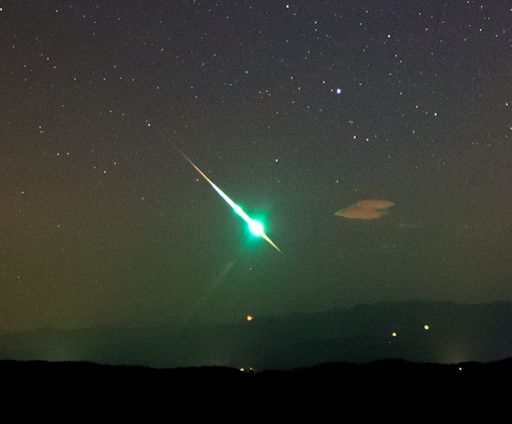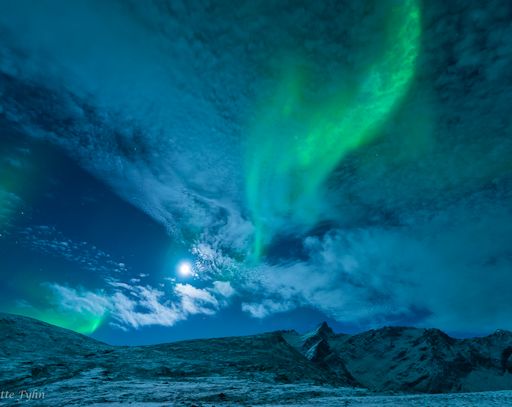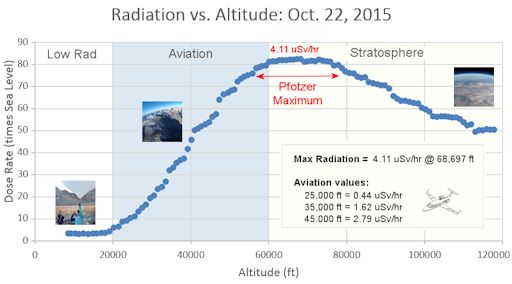Marianne's Heaven On Earth Aurora Chaser Tours Chasethelighttours.co.uk invites you to join them in their quest to find and photograph the Aurora Borealis. Experience the winter wonderland in the Tromsø Area. | | | HALLOWEEN ASTEROID... NASA radars are swiveling to track 2015 TB145, an asteroid the size of a battleship that is passing by the Earth-Moon system today. There's no danger of a collision. At closest approach the space rock will be 300,000 miles away--too far for goosebumps, but close enough for a good view in backyard telescopes: image gallery. Update: There is growing evidence that the Halloween asteroid is actually a dead comet. ... AND HALLOWEEN FIREBALLS: The "Halloween asteroid" is going to miss Earth. The "Halloween fireballs" might not. If forecasters are correct, gravelly debris from Comet Encke could strike our planet's atmosphere this weekend, producing a display of fireballs like this one: 
Marko Korosec took the picture last night in Artvize, Slovenia: "This spectacular meteor had two bright flashes," he says. "It caught me a bit unprepared as I was looking in other direction, saw first flash then looked up and--bam!--the second flash was so bright it lit up the ground." Korosec says the fireball came from the constellation Taurus, which marks it as a meteoroid from Comet Encke. Most debris from Comet Encke is small, dusty and fragile, yielding meteors of ordinary brightness. Taurid fireballs come from a swarm of particles much larger than normal comet dust. They're about the size of pebbles or small stones. The rocky swarm moves within the greater Encke dust stream, sometimes hitting Earth, sometimes not. Will this Halloween be a hit? Korosec's fireball is an encouraging sign. Stay tuned. Realtime Meteor Photo Gallery CME MISSES EARTH, AURORAS APPEAR ANYWAY: A CME expected to deliver a glancing blow to Earth's magnetic field on Oct. 30th did not. It missed. Sky watchers around the Arctic Circle saw auroras anyway. Anne Birgitte Fyhn sends this picture from Kvaløya island, Tromsø, Norway: 
"The partly cloudy weather made this evening extra exciting," says Fyhn. "I was lucky to witness a beautiful show where the auroras and the appearing clouds competed covering the stars." Tromsø is just above the Arctic Circle where even gentle gusts of solar wind can spark Northern Lights--no CME required. More lights could be in the offing. NOAA forecasters say Earth is going to cross a fold in the heliospheric current sheet on Halloween (Oct. 31st), a crossing which could scare up some spooky auroras. Aurora alerts: text or voice Realtime Aurora Photo Gallery
Realtime Space Weather Photo Gallery
Realtime Sprite Photo Gallery
Every night, a network of NASA all-sky cameras scans the skies above the United States for meteoritic fireballs. Automated software maintained by NASA's Meteoroid Environment Office calculates their orbits, velocity, penetration depth in Earth's atmosphere and many other characteristics. Daily results are presented here on Spaceweather.com. On Oct. 31, 2015, the network reported 15 fireballs.
(6 Southern Taurids, 6 sporadics, 2 Northern Taurids, 1 Orionid)  In this diagram of the inner solar system, all of the fireball orbits intersect at a single point--Earth. The orbits are color-coded by velocity, from slow (red) to fast (blue). [Larger image] [movies] Potentially Hazardous Asteroids ( PHAs) are space rocks larger than approximately 100m that can come closer to Earth than 0.05 AU. None of the known PHAs is on a collision course with our planet, although astronomers are finding new ones all the time. On October 31, 2015 there were 1631 potentially hazardous asteroids. Notes: LD means "Lunar Distance." 1 LD = 384,401 km, the distance between Earth and the Moon. 1 LD also equals 0.00256 AU. MAG is the visual magnitude of the asteroid on the date of closest approach. | | Cosmic Rays in the Atmosphere | | Situation Report -- Oct. 30, 2015 | Stratospheric Radiation (+37o N) | | Cosmic ray levels are elevated (+6.1% above the Space Age median). The trend is flat. Cosmic ray levels have increased +0% in the past month. | | Sept. 06: 4.14 uSv/hr (414 uRad/hr) | | Sept. 12: 4.09 uSv/hr (409 uRad/hr) | | Sept. 23: 4.12 uSv/hr (412 uRad/hr) | | Sept. 25: 4.16 uSv/hr (416 uRad/hr) | | Sept. 27: 4.13 uSv/hr (413 uRad/hr) | | Oct. 11: 4.02 uSv/hr (402 uRad/hr) | | Oct. 22: 4.11 uSv/hr (402 uRad/hr) | These measurements are based on regular space weather balloon flights: learn more. Approximately once a week, Spaceweather.com and the students of Earth to Sky Calculus fly "space weather balloons" to the stratosphere over California. These balloons are equipped with radiation sensors that detect cosmic rays, a surprisingly "down to Earth" form of space weather. Cosmic rays can seed clouds, trigger lightning, and penetrate commercial airplanes. Our measurements show that someone flying back and forth across the continental USA, just once, can absorb as much ionizing radiation as 2 to 5 dental X-rays. Here is the data from our latest flight, Oct. 22nd: 
Radiation levels peak at the entrance to the stratosphere in a broad region called the "Pfotzer Maximum." This peak is named after physicist George Pfotzer who discovered it using balloons and Geiger tubes in the 1930s. Radiation levels there are more than 80x sea level. Note that the bottom of the Pfotzer Maximim is near 55,000 ft. This means that some high-flying aircraft are not far from the zone of maximum radiation. Indeed, according to the Oct 22th measurements, a plane flying at 45,000 feet is exposed to 2.79 uSv/hr. At that rate, a passenger would absorb about one dental X-ray's worth of radiation in about 5 hours. The radiation sensors onboard our helium balloons detect X-rays and gamma-rays in the energy range 10 keV to 20 MeV. These energies span the range of medical X-ray machines and airport security scanners. | | The official U.S. government space weather bureau | | | The first place to look for information about sundogs, pillars, rainbows and related phenomena. | | | Researchers call it a "Hubble for the sun." SDO is the most advanced solar observatory ever. | | | 3D views of the sun from NASA's Solar and Terrestrial Relations Observatory | | | Realtime and archival images of the Sun from SOHO. | | | from the NOAA Space Environment Center | | | the underlying science of space weather | | | Web-based high school science course with free enrollment | | 
